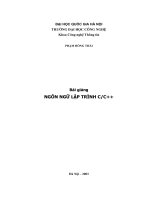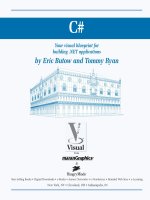Tài liệu C++ Lab 4 Review, Summary & Building Skill Dr. John Abraham Professor, UTPA docx
Bạn đang xem bản rút gọn của tài liệu. Xem và tải ngay bản đầy đủ của tài liệu tại đây (95.91 KB, 4 trang )
Lab 4
Review, Summary & Building Skill
Dr. John Abraham
Professor, UTPA
You learned quite a bit over the last three weeks. It is important that you have a solid
foundation before adding new topics. This session will allow you to practice what you
learned through a series of questions and answers.
lab1
In lab one you learned how to work in the Microsoft dot net environment by writing a
Hello program. Answer the following questions about that program.
/********************************
Say Hello program
By Dr. John Abraham
Created for 1370 students
Teaching objective: program structure
********************************/
#include <iostream>
using namespace std;
int main ()
{
cout << "See mom! I wrote my first C++ program\n";
getchar();
return 0;
}
1.1. What is the purpose of /* */ at the beginning of each of the program?
1.2. This program has one line that starts with a #, and other programs have several lines
that start with #. Explain their purpose. What happens if they are not included in the
program?
1.3. int main () . These three parts of a function heading have specific purposes.
Explain them. Does return 0 have any relation to the function heading? Explain.
1.4. Differentiate between procedure oriented and object oriented programming.
1.5. Show two ways a line-feed can be added to the output.
1.6. The source code is written using an editor. What would be the file extension of the
source code? Explain the stages it must go through until it becomes an executable
program. What happens at each stage?
1.7. Define a variable as related c++. What are the rules about variable identifier names?
(look in the ppt slides for answers). Why is there a type associated with each variable?
1.8. Answer the questions associated with integer operations.
int a = 10, b = 3, c;
c = a / b;
What would be stored in c?______
C = a % b;
What would be stored in c?______ What happened to the previous value?______.
double d = 10.0, e;
e = d/b;
What would be stored in d?_____ Why?________
Is the following operation legal? Explain.
e = d % b;
lab2
***** Program: Calculate area and perimeter of a Circle
By: Dr. John Abraham
Prepared for my CSCI 1370 students
Assignment: number 2
Due Date:
Algorithm:
1. Get the radius of the circle
2. Calculate the perimeter using the equation
perimeter = 2 * radius * PI
3. Calculate the area using the equation
area = radius * radius * PI
4. Print out the perimeter and area
**************/
#include <iostream>
using namespace std;
int main()
{
/*** declarations ****/
const float PI = 3.14;
float radius, area, perimeter;
/**** Input ******/
cout << "Enter the radius of the circle in cm? " ;
cin >> radius;
/**** Process *****/
area = PI * radius * radius;
perimeter = 2 * PI * radius;
/**** output to screen *****/
cout <<endl << "The area of the circle is: " << area << "cm²"
<<endl;
cout <<"The perimeter of the circle is: " <<perimeter << "cm"
<<endl;
}
2.1. Write a function to send the screen output of this program to a file.
2.2. What are the five steps required to create a text file?
2.3. In a program there are certain statements that do not require a semicolon to indicate
the end of the line. What are those statements?
2.4. Differentiate between a constant, variable and #define (Review chapter 3 in your
textbook.)
2.5. Show how to declare variables of data types
integer, float, double, char, and Bool.
2.6. Show how instantiate an object of string class. What is the name of the include file
used?
2.7. What is the purpose of sizeof()?
lab3
3.1. Differentiate between relational operators and Logical Operators. What symbols are
used?
3.2. Why use “else” when you can just use several if statements? When would you use
“else if” versus just “else”.
3.3. What is a block?
3.4. In the program 4-19 on page 201 of your textbook the variable number is declared
twice. Explain the scope of these variables.
3.5. Convert the following statement using conditional operator to statement using if else
statements. X < 0 ? y = 10 : z = 20;
3.6. What happens if you do not use break statement at the end of each case?
Assignment
4.1. In your textbook, page 143, there is a program to calculate the amount of mulch
needed and its price. Modify this program to add a function to perform calculations and
another one to display outputs. Make sure to call these functions from the main. What
happens if you call the display outputs function 3 times? Try it!
4.2. Suppose Green Fields landscaping gives four different prices for mulch depending on
quantity; up to 10 cu yards = $22.00 /cu yard; 11 to 20 cu yards = $19.00/cu yard; 21 to
30 cu yards = 16.00/cu yard and for over 30 cu yards the price is $14.00 /cu yard. You
need to declare 4 different constants, cuYard10, cuYard20, cuYard30 and cuYardGT30.
You also need to modify the function that performs calculations in include if else
statements.









